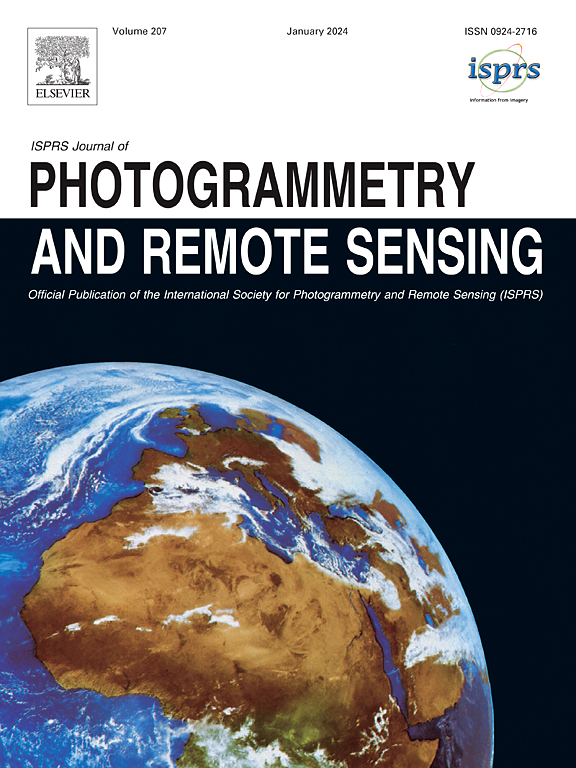GITomo-Net: Geometry-independent deep learning imaging method for SAR tomography
IF 10.6
1区 地球科学
Q1 GEOGRAPHY, PHYSICAL
ISPRS Journal of Photogrammetry and Remote Sensing
Pub Date : 2025-02-01
DOI:10.1016/j.isprsjprs.2025.01.004
引用次数: 0
Abstract
The utilization of deep learning in Tomographic SAR (TomoSAR) three-dimensional (3D) imaging technology addresses the inefficiency inherent in traditional compressed Sensing (CS)-based TomoSAR algorithms. However, current deep learning TomoSAR imaging methods heavily depend on prior knowledge of observation geometries, as the network training requires a predefined observation prior distribution. Additionally, discrepancies often exist between actual and designed observations in a TomoSAR task, making it challenging to train imaging networks before the task begins. Therefore, the current TomoSAR imaging networks suffer from high costs and lack universality. This paper introduces a new geometry-independent deep learning-based method for TomoSAR without the necessity of geometry as prior information, forming an adaptability to different observation geometries. First, a novel geometry-independent deep learning imaging model is introduced to adapt TomoSAR imaging tasks with unknown observation geometries by consolidating the data features of multiple geometries. Second, a geometry-independent TomoSAR imaging network (GITomo-Net) is proposed to adapt the new geometry-independent deep learning imaging model by introducing a transformation-feature normalization (TFN) module and a fully connected-based feature extraction (FCFE) layer, enabling the network to be capable of handling multi-geometries tasks. The proposed method has been validated using real spaceborne SAR data experiments. The average gradient (AG) and image entropy (IE) metrics for the Regent Beijing Hotel region are 7.11 and 2.85, respectively, while those for the COFCO Plaza region are 3.90 and 1.73, respectively. Compared to the advanced deep learning-based TomoSAR imaging method MAda-Net, the proposed method achieves higher imaging accuracy when network training is conducted without prior knowledge of the observation configuration. Additionally, compared to the advanced CS-based TomoSAR imaging method, the proposed method delivers comparable accuracy while improving efficiency by 51.6 times. The code and the data of our paper are available at https://github.com/Sunshine-lch/Paper_Geometry-Idenpendent-TomoSAR-imaging.git.
GITomo-Net:几何无关的SAR层析成像深度学习方法
深度学习在断层SAR (TomoSAR)三维(3D)成像技术中的应用解决了传统基于压缩感知(CS)的TomoSAR算法固有的低效率问题。然而,目前的深度学习TomoSAR成像方法严重依赖于观测几何的先验知识,因为网络训练需要预定义的观测先验分布。此外,在TomoSAR任务中,实际观测值和设计观测值之间经常存在差异,这使得在任务开始之前训练成像网络具有挑战性。因此,目前的TomoSAR成像网络存在成本高、通用性差的问题。本文提出了一种新的基于几何无关的TomoSAR深度学习方法,该方法不需要几何作为先验信息,对不同的观测几何具有适应性。首先,提出了一种新的几何无关的深度学习成像模型,通过整合多个几何形状的数据特征来适应未知观测几何形状的TomoSAR成像任务。其次,通过引入变换特征归一化(TFN)模块和基于全连接的特征提取(FCFE)层,提出了一种几何无关的TomoSAR成像网络(GITomo-Net),以适应新的几何无关的深度学习成像模型,使网络能够处理多几何任务。通过星载SAR实测数据验证了该方法的有效性。北京丽晶酒店区域的平均梯度(AG)和图像熵(IE)分别为7.11和2.85,中粮广场区域的平均梯度(AG)和图像熵(IE)分别为3.90和1.73。与基于深度学习的先进TomoSAR成像方法MAda-Net相比,该方法在不预先了解观测配置的情况下进行网络训练,获得了更高的成像精度。此外,与先进的基于cs的TomoSAR成像方法相比,该方法在提高效率51.6倍的同时提供了相当的精度。我们论文的代码和数据可以在https://github.com/Sunshine-lch/Paper_Geometry-Idenpendent-TomoSAR-imaging.git上找到。
本文章由计算机程序翻译,如有差异,请以英文原文为准。
求助全文
约1分钟内获得全文
求助全文
来源期刊

ISPRS Journal of Photogrammetry and Remote Sensing
工程技术-成像科学与照相技术
CiteScore
21.00
自引率
6.30%
发文量
273
审稿时长
40 days
期刊介绍:
The ISPRS Journal of Photogrammetry and Remote Sensing (P&RS) serves as the official journal of the International Society for Photogrammetry and Remote Sensing (ISPRS). It acts as a platform for scientists and professionals worldwide who are involved in various disciplines that utilize photogrammetry, remote sensing, spatial information systems, computer vision, and related fields. The journal aims to facilitate communication and dissemination of advancements in these disciplines, while also acting as a comprehensive source of reference and archive.
P&RS endeavors to publish high-quality, peer-reviewed research papers that are preferably original and have not been published before. These papers can cover scientific/research, technological development, or application/practical aspects. Additionally, the journal welcomes papers that are based on presentations from ISPRS meetings, as long as they are considered significant contributions to the aforementioned fields.
In particular, P&RS encourages the submission of papers that are of broad scientific interest, showcase innovative applications (especially in emerging fields), have an interdisciplinary focus, discuss topics that have received limited attention in P&RS or related journals, or explore new directions in scientific or professional realms. It is preferred that theoretical papers include practical applications, while papers focusing on systems and applications should include a theoretical background.
 求助内容:
求助内容: 应助结果提醒方式:
应助结果提醒方式:


